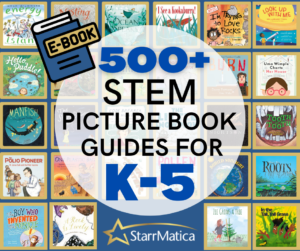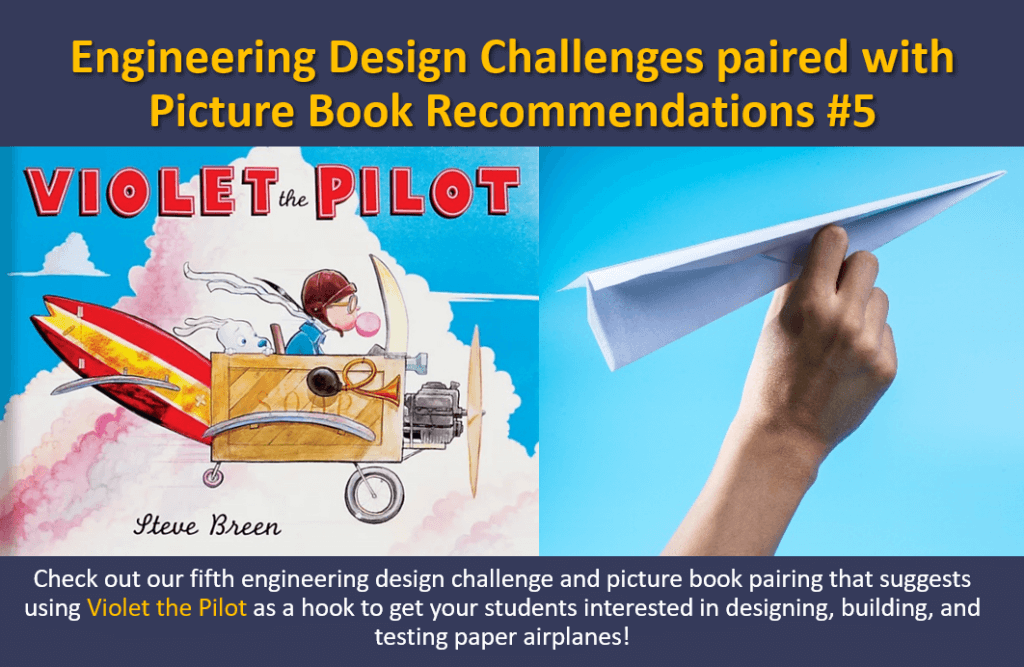Welcome to our fifth engineering challenge post to help you keep your students engaged the last few weeks of school. Click these links to find the first four challenges:
- Challenge #1: Hot Wheels and Roller Coaster
- Challenge #2: Rube Goldberg Machines
- Challenge #3: Building Bridges
- Challenge #4: Ice Cube Insulator
Below, I’ve shared links to several websites with detailed instructions for setting up your paper airplane challenge. Rather than re-invent the wheel, my goal with this post is to share resources and tips to design a lesson that meets your specific classroom needs.
Our fifth challenge is: The Paper Airplane Challenge paired with Violet the Pilot by Steve Breen.
This challenge is a common one you have probably seen (or even tried) before. However, it is a tremendous engineering challenge that can be adapted for any grade level and addresses these NGSS performance expectations:
- K-2-ETS1-2 Develop a simple sketch, drawing, or physical model to illustrate how the shape of an object helps it function as needed to solve a given problem.
- 3-5-ETS1-3 Plan and carry out fair tests in which variables are controlled and failure points are considered to identify aspects of a model or prototype that can be improved.
You could begin your lesson by reading aloud Violet the Pilot by Steve Breen. This picture book tells the story of Violet, a budding engineer, who her peers don’t recognize for her amazing inventions until her plane swoops in to save the day. The book provides a hook to get students thinking about building flying machines (in this case, paper airplanes!).
Reading Activities:
This text is an excellent opportunity to discuss the character traits of perseverance and determination. As you read, ask your students to find evidence in the book of how Violet displays these traits.
The Challenge:
The book provides a nice lead into the challenge of designing a paper airplane. There are a couple of different directions this challenge could go. For example, you could create a challenge for the longest time in the air, the farthest distance, the ability to hit a target, or the ability to fly carrying the most pennies!
Here are a few links to get you started:
Other Considerations:
As I’ve shared in my previous posts, be sure not to give your students too much information before they begin designing their airplanes. Don’t show them videos or do a demonstration about how to fold the perfect airplane. Let them create and test their designs first!
Post Test Activities:
Once you have run your first test, have the students compare their results to each other. You may want to create a class graph of the data to help with comparing. You could give students the opportunity to hypothesize why they believe some designs worked better than others and then to have the chance to design an investigation to test their theories. This might include revising their own designs, creating new designs, and/or collaborating between groups. Some students may also want to do some independent research at this point about what folding methods create an airplane that stays in the air the longest or that flies the farthest. And some students may come up with new questions to investigate. For example, “Will my airplane fly farther outside or inside. Is the weather a factor?”
By continuing the discussion and engineering beyond the first test, you encourage your students to do what “real” engineers do. Testing and making modifications is an integral part of real-world problem solving, and we want to be sure we don’t deprive our students of that experience in our classrooms. The more we can show students early in their careers that failure and revision are a part of the learning process, the more they expect and embrace it in the future.
If you are a StarrMatica Texts: Science Your Way subscriber, you can check out the engineering informational texts below. Remember, each 1st – 5th grade text has multiple reading levels so all of your students can read the same content independently. For example, you could use the 3rd-5th grade engineering texts either before or after your designs. If you choose to use them before, students could model their tests after the engineering steps discussed in the text. If you decide to use them after, students could compare their tests to those in the texts.
- 3rd-5th Engineering: Watering Your Garden on Vacation
- 3rd-5th Engineering: Two Ways to Solve a Problem
- 3rd-5th Engineering: Testing Prototypes
Not a subscriber? Click here for a free trial to access the texts above.
Structure and function and cause and effect are the main crosscutting concepts that fit well with this challenge.
And students are using nearly all of the science and engineering practices. They are developing and using models as they construct their designs. Students are planning and carrying out investigations as they test their airplanes. They are constructing explanations and designing solutions when determining why some designs worked better than others. When they share their designs with peers and discuss the trial results, they obtain, evaluate, and communicate information. When creating graphs and reviewing the trial results, they analyze and interpret data and use mathematics and computational thinking.
And as always, have fun letting your students take the lead!
 Are you are looking for additional picture books for your science classroom, check out the Perfect Picture Book Pairing Series that includes one-page guides with activities and discussion questions for hundreds of STEM-themed picture books aligned to every NGSS performance expectation!
Are you are looking for additional picture books for your science classroom, check out the Perfect Picture Book Pairing Series that includes one-page guides with activities and discussion questions for hundreds of STEM-themed picture books aligned to every NGSS performance expectation!
CLICK HERE TO PREVIEW THE PERFECT PICTURE BOOK PAIRING EBOOKS

